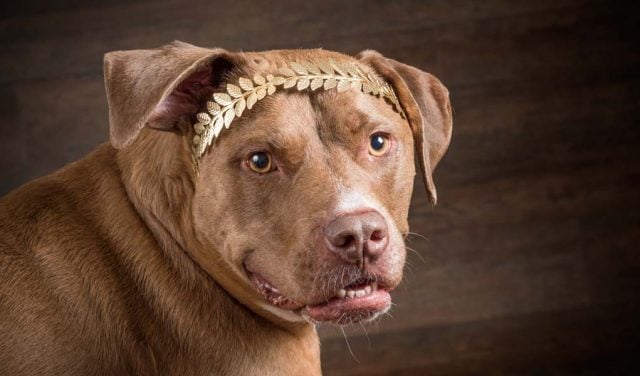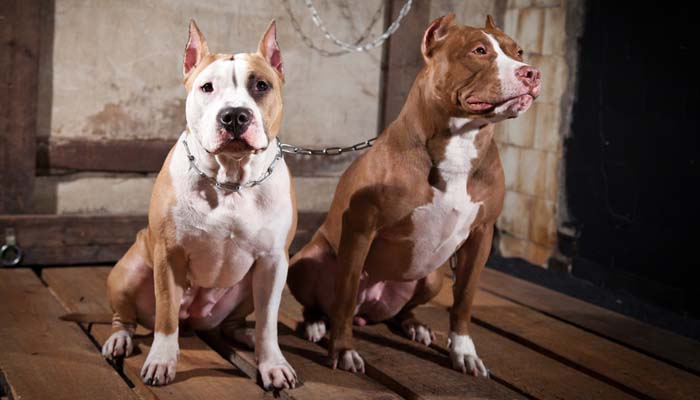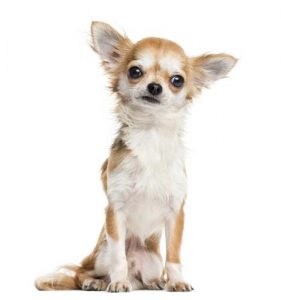
Table of Contents
Stereotypes are, unfortunately, a part of how we function every day; we make generalizations without even really thinking about them. Research shows that often, these stereotypes are not correct. Our dogs are no exception—the most common dog breed stereotypes cause thousands of dogs to sit in shelters every year just because people have the wrong perception of the breed.
We judge a large population of creatures – be them humans or dogs – based on the actions of a rare few. And these most common dog breed stereotypes can be as detrimental to dogs as they are to humans.
Pet adoption suffers from a lot of generalizations. Once a negative stereotype begins to spread, fewer people are willing to adopt certain breeds. Some people will see a mixed breed that has genes from the breed for its negative connotations, and that breed becomes less attractive.
Even as a self-proclaimed “dog person,” I have my own stereotypes about dogs, specific breeds in particular. But I know I’m not alone, so I rounded up the top five most common dog breed stereotypes so we can debunk them together and become true “dog people” – towards all dogs, equally.
ALSO READ: 30 Myths That Many Dog Owners Still Believe
Why Dog Breed Stereotypes Exist?
Before we get into debunking some of these breed stereotypes, let's take a look at why they exist in the first place and how some of us came to believe these false perceptions.
The first and main reason is the dog's purpose. A number of pet owners choose certain dogs for protection, guarding, even dog fighting, and other tasks that involve the dog serving as a threat and deterrent. Therefore, some large, strong, and subjectively mean-looking breeds have long been labeled as the most dangerous dogs out there.
Next comes the dog's genetics. While some of us may not wish to admit this, some breeds, indeed, are more genetically predisposed to be aggressive. Researchers found that it may be the hormones that are causing that aggression, as well as the dog's genetic make-up that causes him to have a slight inclination towards aggression. However, these studies do not align with our perception of certain breeds (small cute dogs that are considered harmless actually can be more genetically aggressive), further proving our bias.
Third, it's the dog's strength. While literally any dog can be aggressive in specific cases, only those that can cause bigger damage will often be singled out. Certain strong dogs are simply more likely to cause serious damage than others. They will be bigger in size and have larger muscle mass and strength. Most importantly, they will have a bigger jaw with stronger bite force. Kangal dog, the dog with the strongest bite force of 743 psi, can cause more harm than a Yorkshire Terrier, but it doesn't mean that it's more aggressive.
Finally, and most importantly, it's the movies and media coverage of certain dogs. It's very common for Hollywood to portray scary-looking dogs as the most aggressive and dangerous, even if they aren't. Pit Bulls – whom we'll cover below – is a good example of this. A dog is aggressive not because it's a Pit Bull but because of the environment it has been raised in. But when these news stories are published, the media goes around this fact and instead lumps Pit Bulls to be associated with fighting and dangerous dogs.
Breed Truths and Overcoming Stereotypes
 To overcome dog breed stereotypes, we must first look at the facts. However, not all facts are equal. For example, just because statistics show that the largest number of bites are caused by Rottweilers doesn't mean that Rottweilers are more likely to be aggressive and bite people for no reason.
To overcome dog breed stereotypes, we must first look at the facts. However, not all facts are equal. For example, just because statistics show that the largest number of bites are caused by Rottweilers doesn't mean that Rottweilers are more likely to be aggressive and bite people for no reason.
It's likely that the number is higher for this breed because owners, as discussed above, choose this breed for protection and may even train it to attack people or other animals, whereas nobody would train a Yorkie to attack people.
Instead, we must look at some aspects that are relevant to the safety of the dog. There are many aspects to consider, one of them being whether a dog can be trained to prevent any unpredictable behavior. Trainers and other canine experts also often test the dog and breeds in general for their temperament, which includes the dog's stability, shyness, aggressiveness, and friendliness, as well as the dog’s instinct to be protective.
Let's take a look at the actual testing of dogs' temperament in a neutral setting. The American Temperament Test Society (ATTS), a not-for-profit organization out of Missouri dedicated to temperament evaluation of dogs, has tested many canines of different breeds on their behavior.
Hundreds of dogs were tested for some of the most popular dog breeds. You can see the full list here, but I will take a look at just one example: Pit Bull came at 87.4% pass rate while Pembroke Welsh Corgi was at 79.2% pass rate. What this means is that your Corgi is more likely to cause harm than your Pit Bull when both are placed in a neutral setting without any prior training. Yet, we don't see Corgis on any “dangerous dogs” lists, do we?
Other facts can also be considered, but without turning this article into a long essay, let's take a look at some of the most common dog breed stereotypes and why they aren't true.
5 Most Common Dog Breed Stereotypes
1. Pit Bulls
You've guessed right that this would be the first one on the list. So much negative media has focused on pit bulls (all of them) lately that it’s hard to know if we should really be worried or not. Even though there are several “types” of bully breeds, these dogs are often classified as “pit bulls” in the media, so we're taking a look at them as such here.
The name “pit bull” simply sounds intimidating to some pet owners due to our personal bias. But it turns out the name comes from their ancestors, bulldogs, who used to rile up bulls during bullfights. Once the bulldogs were bred with terriers, they became smaller and were used for dog fighting in pits – thus the name pit bulls.
The important thing to note here is that pit bulls were bred because they were great fighters, but they were bred for “bite inhibition”—they could be mid-fight, and they would calm at the touch of their owners. But not all pit bulls are aggressive fighting dogs.
While any dog can be traumatized, abused, or even trained to become vicious towards humans and animals, breeders specifically picked pit bulls that were gentle. This means that the breed does not come from a long line of hostile, mean dogs.
While the pit bull nanny dog may be a myth, this breed may still qualify as being one of the most gentle towards humans if raised properly. Nonetheless, pit bulls continue to be discriminated against and the situation is not getting better, thus awareness of this breed's unfair stereotyping is necessary.
2. Rottweilers
Whenever I think of Rottweilers, I think of criminals in movies that have huge rottweilers protecting their property or fighting dogs, like in the movie Amores Perros (2000). In my head, this dog has long been associated with snarls, chasing, and excessive amounts of drool. All of this is a Hollywood perspective, though, and the reality is that Rottweilers are just not trained killers from birth like popular fiction would often portray.
 Breeders who work with Rottweilers note that they are a very easy breed to train, and they are eager to learn and to work. They're obedient dogs that are loyal to their owners.
Breeders who work with Rottweilers note that they are a very easy breed to train, and they are eager to learn and to work. They're obedient dogs that are loyal to their owners.
But this positive thing can easily be turned into a negative, and some believe that these dogs can be easily trained to do “bad things,” which is what results in them being labeled as one of the most scary dogs. It all depends on the person, not the dog. Because of their size, breeders also believe that Rottweilers trigger a fear response in people no matter their temperament.
If not trained properly, they can be very excitable which can be translated into being rough. But the temperament tests that Rottweiler breeders perform indicate that rottweilers have one of the most level, confident temperaments possible and are not easily upset or thrown off course. They are a very level-headed breed. As for me, I’ll have to work on my Hollywood rottweiler prejudices.
3. Doberman Pinscher
When I think of Doberman Pinscher, I automatically think of guard dogs or police dogs, and you probably do too. This isn’t too far off the mark, though, as Dobermans were in fact, bred for protection and guarding, and they're very good at it.
 To give you a very brief history, Karl Friedrich Louis Dobermann started breeding dogs that had excellent sight and hearing, but who were also loyal and fearless; he was a tax collector and very much needed a friendly protector on his side.
To give you a very brief history, Karl Friedrich Louis Dobermann started breeding dogs that had excellent sight and hearing, but who were also loyal and fearless; he was a tax collector and very much needed a friendly protector on his side.
As the breed developed, however, it became clear that Dobermans were much more loyal than they were vicious.
They were (and are) highly intelligent, which means they desire work and tasks, and consistent mental stimulation. They aren’t lazy layabouts. When they aren’t properly exercised or challenged, they tend to get a little antsy. This is where most of the problems arise, breeders say.
Once again, this is a human error – not an innate fault in the breed. People who want to adopt a Doberman should know that their new fur friend will need training, socialization, a lot of exercise and stimulation, and a purpose throughout their days in order to be fully obedient and calm. Only for these reasons is Doberman one of the best police dogs, and not because they may be vicious or scary, which they are not.
4. Chihuahuas
I will admit it first – in the past, I was most guilty of judging Chihuahuas more so than any other breed. I would often automatically assume they’re all mean and cranky based on some of my own past experiences. But like many of the other most common dog breed stereotypes I used to believe, it turns out this is completely untrue.
That said, apparently, I’m not alone, with Chihuahuas being one of the least desired dog breeds in the U.S. – a sad fact indeed. But not all Chihuahuas are created equal.
Many people think Chihuahuas are “yappy” – they never stop barking. However, what breeders and vets have come to find out is that Chihuahuas are very reactive, and unless they’re trained properly from an early age, they will be reactive (yappy) forever. Thus, proper training is very important for this dog breed.
The same goes for socialization – Chihuahuas are not known for their friendliness towards anyone or any dog that they don’t live with, and are worse than Pit Bulls. The reason? Lack of proper training. After talking to experts, I found that breeders attribute this to people’s assumption that small dogs don’t need a ton of training, so they are never properly socialized and, therefore, seem grumpy and mean.
If you adopt a Chihuahua (or really any small toy dog breed), do not neglect the training process. Just because they can’t jump on you or leap a 6-foot fence doesn’t mean they don’t need training. Only proper training, socialization, and plenty of mental stimulation will help deter the negative behavior these dogs are so famous for.
5. Mutts and Mixed Breeds
Nearly 8 million animals enter shelters and rescues every year, according to ASPCA, the majority of them being “mutts,” or mixed breed animals.
 About 3 million of those animals get euthanized every year because they can’t find homes, and it’s believed that the majority of those animals are mixed-breed dogs.
About 3 million of those animals get euthanized every year because they can’t find homes, and it’s believed that the majority of those animals are mixed-breed dogs.
The sad part is that people often want a full-bred dog because they think they know the history of the breed, what to expect from the dog, and can take into account the dog’s background or lineage. That may all be true, but mixed breed dogs may, in fact, be healthier than pedigreed dogs in certain cases (but have poorer health in other cases).
Mixed breed dogs are also a concern for pet owners because “they don’t know what to expect” from the dog’s behavior. What if the dog is part pit bull/Doberman/Chihuahua? As you’ve now learned, those breeds are not “bad”. They simply have a bad reputation due to the most common dog breed stereotypes.
Properly training any dog can solve most of the concerns of potential owners.
A mixed-breed dog has just as much potential to be a great, loving, loyal companion as a purebred. They also may have fewer health problems, have better temperaments, and fit your household better than dogs with a specific history of behavior and health.
READ THIS: Canine Genetics – How to Make a Dog
It’s (Mostly) About the Owner
After discussing the dog stereotype subject above, you're probably sensing a theme here. It seems that it’s almost all about the dog owner and not the dog (for the most part). If the owner adopts a dog of a certain breed that isn’t a good fit for the owner’s lifestyle, trouble ensues.
If the owner doesn’t properly train their dog, more trouble ensues. If an owner doesn’t provide the appropriate routines or activities for their dog, the trouble keeps mounting.
Essentially, the most common dog breed stereotypes we hold are not really based in fact; they’re based on experiences that are entirely subjective to the way a dog is trained. Just take a look at some of the news about Pit Bulls that's been coming out.
READ NEXT: 15 Most Common Myths about Dogs Debunked















